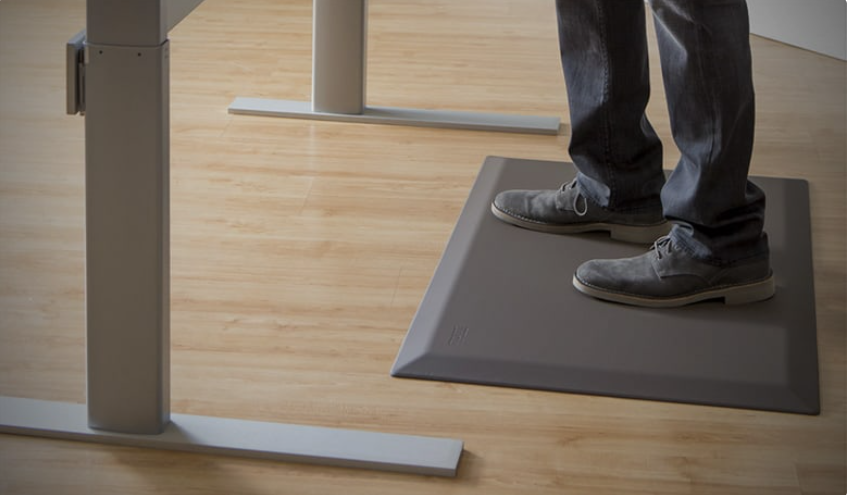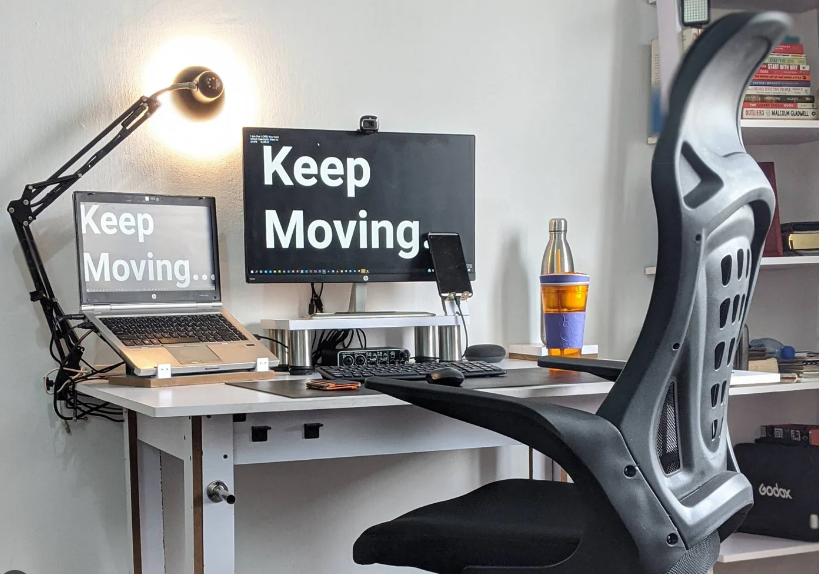Are you considering a standing desk? Standing while you work has numerous benefits for your health and productivity. However, to make the most of your standing desk experience, it’s essential to adopt the right techniques and practices. In this blog post, we’ll share valuable tips and tricks to help you maintain ergonomic posture, enhance comfort, and stay productive throughout the day.
Optimize Health with Balanced Sitting and Standing Intervals
Congratulations on your new height-adjustable standing desk! It’s understandable to feel excited and eager to transition to a standing work routine. However, it’s crucial to start gradually instead of immediately standing all the time. Rushing into continuous standing can be a significant mistake, as abruptly changing your prolonged sitting habit may lead to discomfort and pain. To mitigate these issues, it’s important to create a balanced approach by incorporating intervals of both sitting and standing at your desk. By alternating between the two positions, you can gradually adjust your body and minimize the potential for pain or strain.

The key is to gradually increase the duration of standing intervals over time. It’s important to start with a slow and deliberate approach, initially standing for just a few minutes and then alternating with sitting for a few minutes. There is no fixed rule or specific timeframe for each interval; the goal is to steadily and progressively extend the time spent standing at your standing desk. As you gradually build your tolerance, you’ll be able to stand for over thirty minutes without any discomfort. This should be the target you aim for.
This brings us to the next tip, the correct posture is also very important:
Ergonomic Posture: Your Foundation for Success
Maintaining proper posture is key to reaping the benefits of a standing desk. Adopt these ergonomic guidelines for a healthy and comfortable stance:
1. Relax your shoulders and keep them in a natural position
A simple solution is to incorporate shoulder rolls into your routine. Whenever you notice your shoulders starting to slump, take a moment to do a few shoulder rolls and focus on keeping them straight afterward. With consistent practice, this can become a natural habit and lead to an overall improvement in how you feel. Don’t wait any longer to start making positive changes to your posture and well-being.
2. Ensure your feet are flat on the ground, shoulder-width apart, promoting stability and reducing strain
There are specific rules to follow to avoid discomfort and injury. Simply leaning on the desk or slouching is not the way to stand correctly. To maintain the correct posture, stand straight with your toes pointing forward and feet firmly on the ground. Activate your leg muscles and keep your back and neck upright. Position your neck neutrally, avoiding excessive tilting or craning to minimize neck and back strain.Stick to this standing posture consistently, and you will start to notice significant improvements in your comfort level.
Stay Active with Your Standing Desk: The Importance of Movement
Don’t remain stationary while using a standing desk! It may initially seem counterproductive, but incorporating movement is essential for your overall well-being. Whether you’re working or standing, maintaining a static position for prolonged periods is detrimental to your body. So, once you’ve acclimated to your standing desk, it’s crucial to keep moving.
Take short breaks to walk around your office space or home, promoting blood circulation and rejuvenating your body. If walking isn’t feasible, try performing calf raises or easy exercises right at your standing desk. The key is to keep your body in motion, stimulating energy flow throughout.
Remember, sitting for extended periods can be harmful, but excessive standing without movement can be equally detrimental. By integrating regular movement intervals, you’ll experience renewed energy and heightened productivity when you return to your standing desk.
Relax Your Feet
Just like how sitting for too long can cause pain in your bottom, back, and neck, standing for extended periods can also lead to discomfort in your feet. Fortunately, there are solutions to this issue. You can invest in an anti-fatigue mat or choose the right footwear to provide a soft surface for your feet. Additionally, there are ergonomic anti-fatigue mats designed specifically for standing desks that can help alleviate the pressure on your feet. By using a soft surface, you can reduce the pressure on your feet and prevent blood from pooling, which can cause further problems. To properly utilize a standing desk, it is essential to use a soft and comfortable surface to stand on.

There are some tips on how to choose the right footwear
- Opt for shoes with good arch support to promote proper alignment and reduce foot fatigue.
- Look for cushioning and shock absorption features to minimize discomfort caused by hard surfaces.
- Consider using orthotic inserts or insoles for added support and comfort.

Another tip is to use a lacrosse ball to roll out your feet, it is a simple and effective way to reduce tension and strengthen your arches. After a long day of working in front of a computer or engaging in high-mile workouts, your feet can become sore and uncomfortable. Rolling a lacrosse ball around your feet can help alleviate this discomfort and make the standing portion of your day more bearable.
If you’ve never tried rolling a lacrosse ball along the inner arches of your soles, you may be surprised at the benefits it can provide. Simply moving the ball around with your feet can release tension and improve circulation, helping to keep your feet healthy and strong.
For those who use standing desks, rolling out your feet with a lacrosse ball can be especially beneficial. By taking the time to release tension that becomes built up throughout the day, you can improve your overall comfort and reduce the risk of injuries or conditions associated with prolonged standing.
So if you’re looking for a simple and effective way to improve your foot health and reduce discomfort during long periods of standing, consider using a lacrosse ball to roll out your feet. You may be surprised at how much of a difference it can make!
Optimize Your Health and Comfort with Proper Ergonomic Setup
To avoid discomfort and injury, it is essential to set up your height adjustable desk correctly. Optimal alignment can be achieved by positioning your monitor at eye level and your keyboard at chest height. These simple adjustments are crucial for a healthy workspace that maximizes comfort and productivity.
Enhance your workspace with ergonomic accessories such as a monitor arm, keyboard tray, document holder, or adjustable desk lamp. These additions can help alleviate eye and wrist strain, improve posture, and boost efficiency. Investing in essential adjustments and accessories optimizes your health and comfort while working.

Plus, here are some tips for adjusting your keyboard and mouse position. Long hours of keyboard use can lead to wrist strain, but proper positioning can prevent pain and discomfort. If you are standing, position your wrist slightly more tilted upwards than when you are sitting.
If your standing desk is at the correct height but your wrists are still not in an optimal position, consider using a pad to raise your keyboard to the required level. These small adjustments go a long way in promoting a health-conscious workspace.
In addition, when using a standing desk, it’s important to take extra care with your cables. Check that the desk configuration works for both sitting and standing modes to avoid any accidents. If you have multiple power cables, it’s worth investing in a cable management system to prevent any damage or stress on the cables when the desk adjusts. After all, the last thing you want is for your laptop to come crashing down from the desk if the power cable gets pulled out during adjustment. Avoid any mishaps and keep your workspace organized with proper cable management.

AOKE Cable Management Spine
What’s more, investing in a standing desk is a smart way to reduce stress on your body, but to fully optimize your ergonomic setup, choosing the right chair is crucial.
Sitting on an ergonomic chair promotes good posture and helps keep your core muscles engaged, even if you are not standing. This means you can enjoy the benefits of standing while resting your joints. We recommend active sitting, which involves sitting on a chair that encourages movement and ranges of motion. This approach helps to improve blood circulation, reduces stiffness, and increases productivity.
Track and Optimize Sitting and Standing Periods for Better Health
Prolonged sitting or standing can lead to health problems, which is why it’s important to switch positions frequently. Experts suggest standing for at least 30-45 minutes per hour, followed by a 15-minute sitting break to give your legs a rest. However, everyone is different, so finding the right balance of sitting and standing for your body is key.
To optimize your comfort and energy levels, start tracking your sitting and standing time. This will help you identify the optimal combination that works best for you. Additionally, many standing desks come equipped with memory settings that make it easy to switch between sitting and standing positions.
When the arms are at a 45 degree angle, the standing desk can be used comfortably. With AOKE’s standing desks, you can set the perfect height and then program the desk to remember those heights and adjust to them in the pre-settings. So don’t wait any longer and take advantage of these tools to improve your health and productivity!
Take Microbreaks: Energize Your Body and Mind
Microbreaks are short and efficient breaks that are designed to reenergize your body and mind while promoting productivity and focus. Taking microbreaks is easy, and you don’t have to leave your workstation. Simply schedule a short break every hour to stretch and move around.
During your microbreaks, you can incorporate gentle exercises, such as leg swings and arm circles, to improve blood circulation and prevent muscle stiffness. You can also take a brief walk around the office or outside to get some fresh air and sunlight.
Don’t underestimate the power of microbreaks. They are essential in increasing your overall energy levels throughout the day and reducing the risk of musculoskeletal disorders. So, take a few minutes every hour to recharge, and you’ll be amazed at how much better you will feel. Remember, your body and mind deserve a break!
Conclusion
In conclusion, implementing a standing desk into your work routine can do wonders for your health and productivity. However, to truly reap the benefits, it’s important to go beyond simply standing in place. By following the expert tips and tricks outlined in this article, you can create a comfortable, ergonomic, and engaging workspace that will help you stay focused and energized throughout the day.
Keep in mind that there’s no one-size-fits-all solution when it comes to standing desks. Experimenting with different positions and accessories can help you find what works best for you and your unique needs.
By taking these steps, you’ll be well on your way to achieving a healthier, more productive workday. So, don’t hesitate to try out these standing desk tips and tricks and share your own insights in the comments below. Here’s to a more comfortable and productive workday for everyone!
